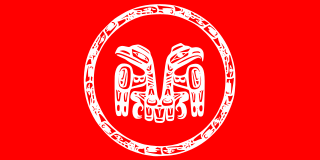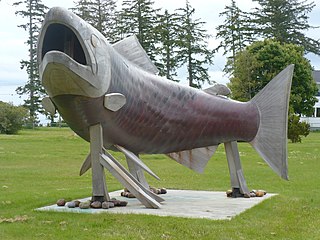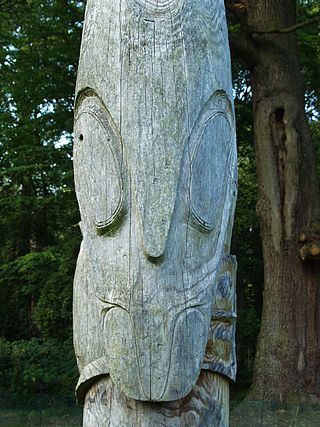Related Research Articles

William Ronald Reid Jr. was a Haida artist whose works include jewelry, sculpture, screen-printing, and paintings. Producing over one thousand original works during his fifty-year career, Reid is regarded as one of the most significant Northwest Coast artists of the late twentieth century.

The Haida are an Indigenous group who have traditionally occupied Haida Gwaii, an archipelago just off the coast of British Columbia, Canada, for at least 12,500 years.

Totem poles are monumental carvings found in western Canada and the northwestern United States. They are a type of Northwest Coast art, consisting of poles, posts or pillars, carved with symbols or figures. They are usually made from large trees, mostly western red cedar, by First Nations and Indigenous peoples of the Pacific Northwest Coast including northern Northwest Coast Haida, Tlingit, and Tsimshian communities in Southeast Alaska and British Columbia, Kwakwaka'wakw and Nuu-chah-nulth communities in southern British Columbia, and the Coast Salish communities in Washington and British Columbia.

Emily Carr was a Canadian artist who was inspired by the monumental art and villages of the First Nations and the landscapes of British Columbia. She also was a vivid writer and chronicler of life in her surroundings, praised for her "complete candour" and "strong prose". Klee Wyck, her first book, published in 1941, won the Governor General's Literary Award for non-fiction and this book and others written by her or compiled from her writings later are still much in demand today.

Haida Gwaii, also known as the Queen Charlotte Islands, is an archipelago located between 55–125 km (34–78 mi) off the northern Pacific coast of Canada. The islands are separated from the mainland to the east by the shallow Hecate Strait. Queen Charlotte Sound lies to the south, with Vancouver Island beyond. To the north, the disputed Dixon Entrance separates Haida Gwaii from the Alexander Archipelago in the U.S. state of Alaska.

Queen Charlotte Sound is a sound of the Pacific Ocean in British Columbia, Canada, between Vancouver Island in the south and Haida Gwaii in the north. It merges with Hecate Strait in the north and Queen Charlotte Strait in the south.

Masset is a village in the Haida Gwaii archipelago in British Columbia, Canada. It is located on Masset Sound on the northern coast of Graham Island, the largest island in the archipelago, and is approximately 50 km (31 mi) west of mainland British Columbia. It is the primary western terminus of Trans-Canada Highway 16 and is served by Masset Airport, with flights to Vancouver and Prince Rupert. During the maritime fur trade of the early 19th century, Masset was a key trading site. It was incorporated as a village municipality on May 11, 1961.

Sandspit is the largest community on Moresby Island, in Haida Gwaii off the Pacific coast of British Columbia, Canada. The only town on Moresby Island, Sandspit has accommodations, a campground, supermarket and 85-berth harbour serving visitors to Gwaii Haanas.
Robert Charles Davidson, is a Canadian artist of Haida heritage. Davidson's Haida name is G̲uud San Glans, which means "Eagle of the Dawn". He is a leading figure in the renaissance of Haida art and culture. He lives in White Rock, British Columbia.
Freda Diesing was a Haida woman of the Sadsugohilanes Clan, one of very few female carvers of Northwest Coast totem poles and a member of the Council of the Haida Nation of British Columbia, Canada. Her Haida name is Skil Kew Wat, meaning "magical little woman."

Florence Edenshaw Davidson (1896–1993) was a Canadian First Nations artist from Haida Gwaii. She created basketry and button blankets and was a respected elder in her village of Masset, Haida Gwaii, British Columbia.
Reg Davidson is an Aboriginal Canadian carver and a member of the Haida band government.

Charles Edenshaw was a Haida artist from Haida Gwaii, British Columbia. He is known for his woodcarving, argillite carving, jewellery, and painting. His style was known for its originality and innovative narrative forms, created while adhering to the principles of formline art characteristic of Haida art. In 1902, the ethnographer and collector Charles F. Newcombe called Edenshaw “the best carver in wood and stone now living.”

Norman Tait was a Nisga'a First Nations sculptor and totem pole carver from northwestern British Columbia, Canada.
Michael Nicoll Yahgulanaas is a visual artist, author, and public speaker. His work has been seen in public spaces, museums, galleries and private collections across globe. Institutional collections include the British Museum, Metropolitan Museum of Art, Seattle Art Museum, Vancouver Art Gallery, and the Humboldt Forum.

SG̱ang Gwaay Llnagaay, commonly known by its English name Ninstints, is a village site of the Haida people and part of the Gwaii Haanas National Park Reserve and Haida Heritage Site on Haida Gwaii on the North Coast of British Columbia, Canada.

Primrose Adams was a Canadian First Nations artist and member of the Raven Clan from the Haida nation. She wove hats and baskets in the Haida method and is most notable for her spruce root basketry, which involves working in the traditional manner of collecting and dyeing her own spruce root. Adams died in January 2020.

James Hart is a Canadian and Haida artist and a chief of the Haida Nation.
Kevin Eastwood is a Canadian documentary filmmaker and film and television producer. He is best known for directing the Knowledge Network series Emergency Room: Life + Death at VGH and British Columbia: An Untold History and the CBC Television documentaries Humboldt: The New Season and After the Sirens. His credits as a producer include the movies Fido, Preggoland and The Delicate Art of Parking, the television series The Romeo Section, and the documentaries Haida Modern, Haida Gwaii: On the Edge of the World and Eco-Pirate: The Story of Paul Watson.

Gwaai Edenshaw is a Haida artist and filmmaker from Canada. Along with Helen Haig-Brown, he co-directed Edge of the Knife, the first Haida language feature film.
References
- ↑ Macnair, Peter L.; Hoover, Alan L.; Neary, Kevin (1984). The Legacy: Tradition and Innovation in Northwest Coast Indian Art . Vancouver, B.C.: Douglas & McIntyre. ISBN 978-0295961668.